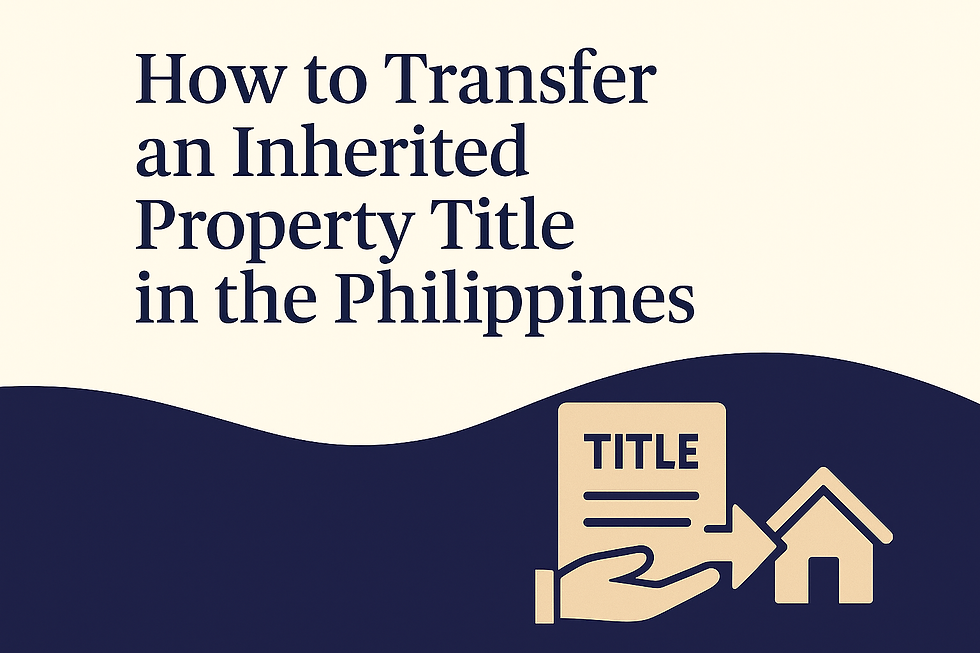Understanding Documentary Stamp Tax and Transfer Fees in Philippine Real Estate
- cristino rosales
- Nov 1
- 3 min read
Updated: Nov 3
So, you’ve sold a property or maybe bought one — congratulations! But before that new title officially bears your name, there’s a paper trail (and yes, a few taxes) you’ll need to settle.
Aside from Capital Gains Tax (CGT), two other costs often raise eyebrows among property sellers and buyers: Documentary Stamp Tax (DST) and Transfer Fees.
Don’t worry — let’s break them down in plain, human terms.

1. What Is the Documentary Stamp Tax (DST)?
Think of DST as a payment for the legal recognition of your real estate transaction. It’s the government’s way of “stamping” your Deed of Absolute Sale and saying, “Yes, this is valid.”
It applies to every sale or transfer of real property in the Philippines, whether you’re selling a vacant lot, a condo unit, or a house and lot.
How to Compute the DST
The Documentary Stamp Tax is 1.5% of the higher value between:
The Selling Price (in your Deed of Sale)
The Zonal Value (set by the BIR)
The Fair Market Value (from the local Assessor’s Office)
Formula: DST = Higher Value × 1.5%
Example: If your property’s selling price is ₱3,000,000, but the BIR’s zonal value is ₱3,500,000,
You’ll use ₱3,500,000 as the basis.
So: ₱3,500,000 × 1.5% = ₱52,500 DST
That’s what you’ll pay to the Bureau of Internal Revenue (BIR) before you can process your title transfer.
2. What Are Transfer Fees?
After paying your taxes (CGT and DST), it’s time to officially move the property title to the buyer’s name — and that’s where Transfer Fees come in.
Transfer Fees are paid to the City or Municipal Treasurer’s Office and serve as the processing fee for registering the new ownership with the Register of Deeds.
How to Compute Transfer Fees
Rates vary slightly depending on the city or municipality, but it’s usually around 0.5% to 0.75% of the property’s value.
Formula: Transfer Fee = Higher Value × (0.5% to 0.75%)
Example: ₱3,500,000 × 0.5% = ₱17,500 Transfer Fee
Tip: Some cities (like Makati or Taguig) use the higher 0.75% rate, so it’s best to check with your local Treasurer’s Office.
3. Summary of Key Real Estate Taxes & Fees
Type of Fee | Who Pays | Rate | Paid To | Based On |
Capital Gains Tax (CGT) | Seller | 6% | BIR | Higher of Selling or Zonal Value |
Documentary Stamp Tax (DST) | Buyer | 1.5% | BIR | Higher of Selling or Zonal Value |
Transfer Tax | Buyer | 0.5%–0.75% | City/Municipality | Higher of Selling or Zonal Value |
Registration Fee | Buyer | ~₱8,000–₱20,000 (approx.) | Register of Deeds | Schedule-based |
4. Step-by-Step Flow (Buyer’s Side)
Pay Documentary Stamp Tax at BIR
Secure Certificate Authorizing Registration (CAR)
Pay Transfer Tax at the City or Municipal Treasurer’s Office
Submit to the Register of Deeds for Title Transfer
Update Tax Declaration at the Assessor’s Office
Final Thoughts
The truth is, paying taxes and fees can feel like a maze — but once you know what’s what, it all makes sense.
Here’s a simple way to remember it: “The seller pays the gain, the buyer pays the paper.”
Meaning:
Seller → Capital Gains Tax
Buyer → Documentary Stamp Tax, Transfer Fees, and Registration Fees
Whether you’re selling your first home or closing a deal as an investor, knowing these helps you prepare financially — and avoid surprises at the City Hall counter.
Author’s Note
Written by Cris Rosales Jr., founder of A Little Bit of Everything in Life — a space where real estate, personal finance, and everyday wisdom meet in one conversation at a time.



Comments